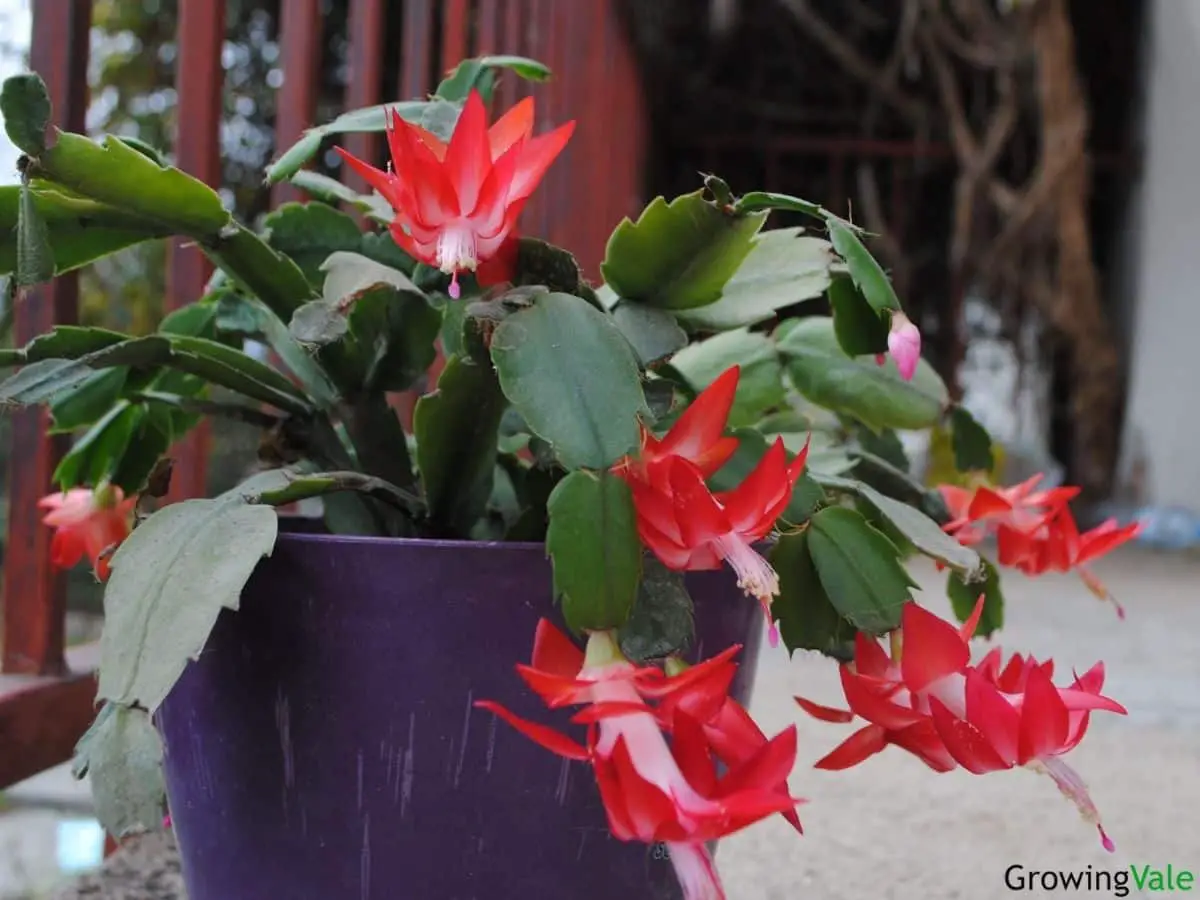Plants in the Schlumbergera genus are often commonly called holiday cactus. But, beware of common names because they can sometimes be both misleading and misused. For example, Schlumbergera truncata (Thanksgiving cactus) is often sold with the common name of Christmas cactus (Schlumbergera x buckleyi).
Although these plants are very similar, they do differ in when they flower and the shape of their leaves. But, no matter which species you end up with, you’re really going to enjoy growing these lovely succulents with their bright and cheerful flowers.
These plants are relatively easy to grow and can tolerate a little more water than other species of cacti. Plus, they do enjoy a certain amount of humidity and prefer to be grown in partial shade with exposure to indirect sunlight in the morning.
Let’s explore the different varieties of Schlumbergera, so that you can identify them correctly and then learn how to care for a christmas cactus.
Schlumbergera truncata (Thanksgiving cactus or Zygocactus)
The Thanksgiving cactus is probably the most popular species that are widely grown by gardeners around the world. Typically, it flowers from fall through late winter (November through to February). You can easily differentiate this plant from the true Christmas cactus by closely looking at its leaves.
Like all Schlumbergera, the leaves are actually stem sections, but the ones on this plant have very distinctive “claws” or toothed notches on either side of each leaf or stem section near the end. This gives them their other common name of Crab Claw cactus.
Like all the plants in this genus, the flowers form on the end of each pendulous stem. These flowers come in various colors including red, pink, purple, white, and orange.
There are now many hybrids available for this species of cactus that have been cultivated by plant growers around the world. This has increased the number of flower colors available and you might now find hybrids with salmon, peach, coral, or yellow flowers as well.
Schlumbergera x buckleyi (True Christmas cactus)
This is the true Christmas cactus and the leaves or stem sections do not have the “claws” like the Thanksgiving cactus. Rather, the leaves are more scalloped around the edges.
Interestingly, this plant is not a “true” species but rather, a cross between Schlumbergera truncata and Schlumbergera russelliana. This hybrid was created way back in 1850 by horticulturalist W. Buckley.
This plant also blooms a little later than Schlumbergera truncata from late winter to early spring (December to February). The flowers on this species are normally a bright reddish-pink color.
Hopefully, this will allow you to tell the difference between the Thanksgiving cactus and the true Christmas cactus. But don’t worry because both are easy to grow and make a delightful addition to your cactus collection.
Schlumbergera opuntioides
This is quite a rare species and is entirely different from other holiday cactus varieties although its flowers are very similar. This plant has thick, succulent branched stem sections that look more like the Opuntia cacti. These stem segments are flat, to begin with, but become more cylindrical as the plant ages. They also have short sharp spines growing from wooly areoles.
The flowers on this species are normally pink to purple.
Schlumbergera russelliana
This plant is very similar in appearance to the true Christmas cactus. It has the same scalloped green stem sections or leaves and the flowers bloom on the end of each stem section. The difference is that this plant actually blooms in spring with flowers in different shades of pink.
Schlumbergera bridgesii (Christmas cactus)
This is another interesting species of holiday cactus and very similar to the true Christmas cactus. It has the same flattened and scalloped stem sections but the flowers not only grow from the ends of these segments but can also grow from the notches between each segment.
The flowers are very similar in form to those of fuchsias and will last for quite some time.
Schlumbergera gaertneri (Easter or Spring cactus)
Although the Easter cactus is similar in appearance to the true Christmas cactus, its accepted botanical name is Hatiora gaertneri. However, it is commonly sold as Schlumbergera gaertneri. Botanical nomenclature can be so confusing sometimes!
The stems on this plant tend to become woodier and the fleshy leaves are not as obviously notched. The flowers do appear at the end of the stems but are more open and star-shaped.
Schlumbergera truncata ‘Bridgeport’
This cultivar has the most gorgeous white flowers with bright pink stigma and style. However, the flowers are only white when the plant is grown in temperatures below 60 degrees Fahrenheit (15 degrees Celsius), otherwise, they’re a pale pink.
Like Schlumbergera truncata, the leaves have toothed margins and are flattened.
See more cactus types you can grow on our blog.

